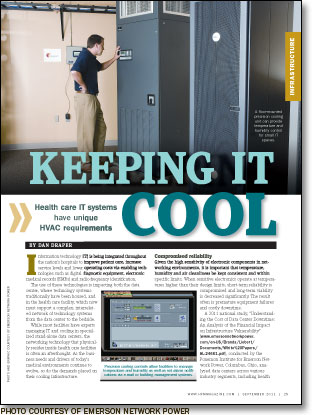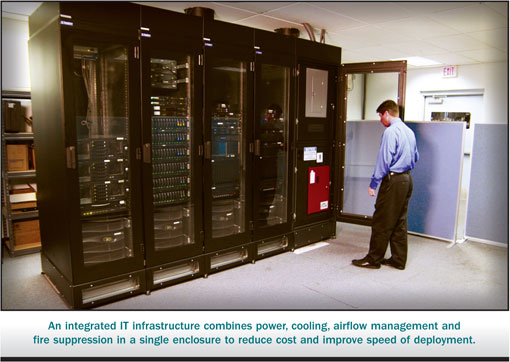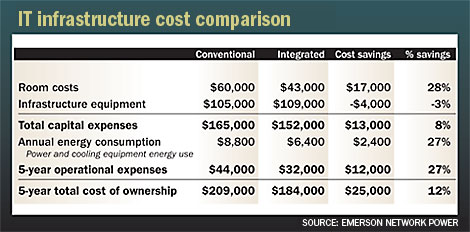 Information technology (IT) is being integrated throughout the nation's hospitals to improve patient care, increase service levels and lower operating costs via enabling technologies such as digital diagnostic equipment, electronic medical records (EMRs) and radio-frequency identification.
Information technology (IT) is being integrated throughout the nation's hospitals to improve patient care, increase service levels and lower operating costs via enabling technologies such as digital diagnostic equipment, electronic medical records (EMRs) and radio-frequency identification.
The use of these technologies is impacting both the data center, where technology systems traditionally have been housed, and in the health care facility, which now must support a complex, interrelated network of technology systems from the data center to the bedside.
While most facilities have experts managing IT and cooling in specialized stand-alone data centers, the networking technology that physically resides inside health care facilities is often an afterthought. As the business needs and drivers of today's medical environments continue to evolve, so do the demands placed on their cooling infrastructure.
Compromised reliability
Given the high sensitivity of electronic components in networking environments, it is important that temperature, humidity and air cleanliness be kept consistent and within specific limits. When sensitive electronics operate at temperatures higher than their design limits, short-term reliability is compromised and long-term viability is decreased significantly. The result often is premature equipment failures and costly downtime.
A 2011 national study, "Understanding the Cost of Data Center Downtime: An Analysis of the Financial Impact on Infrastructure Vulnerability", conducted by the Ponemon Institute for Emerson Network Power, Columbus, Ohio, analyzed data centers across various industry segments, including health care, to identify the frequency and cost of downtime. The report found that 95 percent of the participating IT users experienced an unplanned outage over the previous two years. It also discovered the average cost of a partial IT shutdown is $258,149 and a full shutdown costs more than $680,000.
With the increased dependence on technology, an IT disruption inside the hospital or health care facility can lead to lost patient data, corrupted diagnostic images, damage to IT or medical equipment, compromised patient safety and staff satisfaction, and lost potential revenue because equipment is unavailable during reboot or recharge.
Whether due to rapid, unanticipated growth or a general lack of awareness regarding the cooling requirements for sensitive electronic equipment, some organizations wrongly utilize comfort cooling systems to keep electronic components cool. This is often because the differences between comfort and precision cooling systems can be ambiguous.
Precision vs. comfort
Comfort cooling systems, which include room air conditioners and air conditioning systems for office and commercial buildings, are engineered primarily for the intermittent use required to maintain a comfortable environment for people in facilities with a moderate amount of in-and-out traffic. They typically operate about 2,500 hours per year and allow for large fluctuations in temperature and humidity. While these systems are capable of effectively maintaining acceptable conditions for human occupants, they are not designed to regulate humidity and temperature within precise margins.
Precision cooling systems, or computer room air conditioners, are engineered primarily for facilities that require year-round constant cooling, precise humidity control and a higher cooling capacity per square foot. They operate 24 hours a day, 365 days per year, and offer microprocessor control of temperature and humidity.
This type of environmental conditioning can utilize a wide range of cooling mediums, including air, chilled water and pumped refrigerants. Because precision cooling units are engineered for continuous performance and efficiency, the average total cost of ownership (TCO) for comfort cooling systems may be as much as 60 percent higher than that of precision cooling systems.
To better understand the difference, it is important to remember there are two types of cooling — latent and sensible. Latent cooling is the ability to remove moisture from the surrounding environment. This is an important component in typical comfort-cooling applications that are designed to maintain a comfortable balance of temperature and humidity in office buildings and other facilities with high human occupancies and uses. Sensible cooling, on the other hand, is the ability to remove heat that only can be measured by a thermometer.

The increased amount of IT equipment found within health care facilities generates sensible heat, which is a drier heat than typically found in traditional room environments. Comfort cooling systems are 60 to 70 percent dedicated to lowering temperature and 30 to 40 percent dedicated to lowering humidity. Conversely, precision cooling systems devote 80 to 100 percent of their efforts to lowering temperature and only 0 to 20 percent to lowering humidity.
Unlike facilities that need to take occupant comfort into consideration, data center environments — particularly network closets and independent distribution frame/main distribution frame rooms — typically are not occupied by people. In most cases, they have limited access. And because their environment primarily is composed of dry heat, IT rooms require minimal moisture removal.
Computing requires cooling
As health care organizations become increasingly reliant on digital technologies to help improve patient care, increase efficiency and lower costs, computing and IT environments are extending from specialized data centers to the point of care, whether in a hospital or a remote doctor's office. Considerations for these two environments include the following:
Hospital network closets. While a growing number of hospitals have centralized data centers, network closets in most cases are the backbone of the health care facility's communications and data network. To ensure patient data is always available at the point of care, the network closet IT infrastructure, including cooling, must be designed properly.
As a hospital adds more IT equipment to its closets, more heat is produced by the servers, routers and other IT gear, which can shorten operating life. The general rule is every 10-degree increase over 80 degrees produces a 50 percent reduction in long-term reliability of IT hardware. Cutting the operating life of computing equipment by half not only impacts patients through unplanned downtime, but the cost of replacing IT quickly can outpace the cost of having a proper cooling system installed up front.
Not all network closets require precision cooling. Such factors as the amount of IT in the room coupled with the room size and existing ventilation mean there are few rules of thumb when it comes to cooling. However, typically when the IT computing load exceeds 1,000 watts, precision cooling — which also can provide necessary humidification — likely is necessary to maintain performance and availability.
There are many options available for precision cooling solutions which conform to specific spaces and closet layouts. Configurations include floor-mounted, wall-mounted, ceiling-mounted and even rack-integrated cooling. The latest innovation in cooling for small spaces is the development of integrated infrastructures which combine power and cooling into a sealed enclosure for room-neutral deployments (see sidebar at right). The best option depends on physical limitations of the facility and the amount of cooling needed.
Remote physician offices. Just as hospitals have small IT rooms filled with network and computing gear, ambulatory and office environments will have matching rooms that connect the stand-alone clinics and practices to the parent hospital's digital network.
In these spaces, a building or comfort air conditioner is regulating the environment as it is cooling the people who work in the office. But, besides the general limitations of comfort systems compared with precision cooling, ambulatory care providers are typically office environments — meaning at the end of the day everyone goes home and the lights go off.
The building's air conditioning system follows that schedule as well. Unfortunately, the IT equipment does not turn off; it continually runs and generates heat. Without cooling, the operating life will degrade quickly and availability of the IT will be compromised greatly.
These ambulatory spaces are in the most need of attention. As physicians experiment with mobile computing and EMRs, they typically do not have knowledge or access to experts who can implement high-availability computing. With more ambulatory offices coming under the umbrella of a parent hospital, the situation improves as facility and IT experts can implement best practices for these small spaces.
Cooling best practices
As the facilities and IT departments of health care organizations continue to be challenged by a wide array of objectives, there are a number of proven best practices for improving efficiency in a strategic manner that spans all facets of the cooling infrastructure, without adversely impacting availability or inflating the TCO. These best practices, which apply to very small spaces as well as the largest data centers in the world, include the following:
Maximize return temperature at cooling units to improve capacity and efficiency. As heat densities continue to rise, airflow management is a growing concern. Fortifying data center or networking environments with adequate cooling capacity is no longer enough. Adopting an airflow management strategy suited for high-density computing is critical to maximizing efficiency and preserving availability by minimizing the occurrence of hot spots.
Facility professionals should make sure the hot air return ducting is capturing the hottest air from the backs of the IT equipment. In the same regard, the output of the precision cooling unit should be directed to the intake of the computing equipment and the hot and cold air streams should be made as separate as possible.
Match cooling capacity and airflow with IT loads. Today's computing loads are dynamic and have peaks and valleys of utilization. To maximize efficiency of data center and networking environments, the output of the precision cooling units should match the varying requirements of the IT load.
By reading the temperature and using digital scroll compressors and variable-frequency drives, cooling will match the load and prevent overcooling during times of low IT utilization. This will save significant operating expenses and can improve TCO by ensuring the cooling unit is not working at 100 percent all of the time.
Utilize cooling designs that reduce energy consumption. Because precision cooling units run 24/7, they consume a significant amount of electricity. By utilizing units designed with fewer energy-consuming parts or with options that can turn components off, significant operating cost savings can be realized. Such energy-saving features of precision cooling units include high-efficiency motors and digital scroll compressors.
Remotely manage and monitor cooling. While most organizations want to minimize the cost of physically inspecting and maintaining equipment in network closets, they also want to be able to detect any adverse trends before they turn into emergencies. Remote monitoring and management software can identify adverse changes in the environment and equipment, including shifts in heat and humidity as well as cooling equipment status.
Network management software can be used to determine the status of cooling equipment and automate the graceful shutdown of equipment during a prolonged power outage. Remote management is especially useful in hospitals with several network closets, or when hospitals centrally manage multiple, remote ambulatory offices as part of a core network. These monitoring features give health facility professionals visibility across many disparate locations.
Use local design and service expertise. Cooling is often complicated. Contractors and engineers usually are needed to extend equipment life, reduce costs and address unique challenges. There are a number of vendor partners that offer a broad range of cooling solutions ideally suited for critical health care IT environments, both large and small.
Turning into data centers
Hospitals and ambulatory care facilities are turning into IT data centers, with complex interrelated technology networks, and these spaces must be treated like data centers.
To ensure continuous availability of life-critical information and equipment, hospitals need to give thought to their IT cooling infrastructure and ensure they have the proper cooling solution to ensure availability and efficiency while enabling future growth.
Dan Draper is manager of strategic marketing and research for Emerson Network Power, Columbus, Ohio. He can be reached at dan.draper@emerson.com.
| Sidebar - Stand-alone IT infrastructure tested in health care environments |
| As information technology (IT) environments extend from centralized data centers to the point of care, there are new solutions that allow health facilities to power and cool critical technology systems easily and efficiently. One option is a stand-alone, integrated infrastructure that supports IT equipment in an enclosed, multi-rack configuration with integrated power, cooling, infrastructure management and fire suppression. These integrated infrastructure solutions are simple to configure and deploy in virtually any room, without any significant changes to the room — even in locations where people are working. This makes them ideal for health care environments that support a complex network of technology systems. All that is required is power and access to ducting to expel the heat. Integrated solutions easily solve the complicated questions of power, cooling and security for IT in small spaces. In a series of beta tests, health care facilities and data center design firms were asked to compare the integrated approach to a conventional one in which a special room would be built for IT. The scenarios examined a data center requiring a capacity of 18 kilowatts of IT equipment and a comprehensive power and precision cooling infrastructure in a non-IT-ready room. While both approaches required the same amount of IT equipment and supporting power and cooling infrastructure, the conventional approach required extensive renovations to the rooms housing the equipment. Because the rooms usually were closets or vacant office spaces, installation of specialized systems, such as vapor barriers and fire suppression, were required to turn them into IT-capable rooms. Utilizing the data in the table below, the design firms calculated the capital and operating costs of the two designs. While the integrated solution required a slightly greater investment for infrastructure equipment (approximately $4,000 over a conventional approach), the utilization of an integrated solution offered significant savings ($17,000 or 28 percent) on room costs due to integrated fire suppression systems and the room-neutrality benefits afforded by the enclosure. Because the integrated solution employs a closed-loop cooling design as opposed to traditional ceiling-mount precision cooling, servers can be cooled effectively at much higher densities, maximizing intake temperatures to ensure that cooling capacity is not wasted — in turn, maximizing the efficiency of the system. As a result, the integrated solution consumes nearly 30 percent less energy annually compared with the conventional infrastructure configuration and produces an overall total cost of ownership savings of $25,000, or 12 percent less than its conventionally designed counterpart. With IT expanding faster than existing capacity can handle, many small hospitals and ambulatory care facilities have opted for an integrated approach to addressing the complexities and expenses of designing dedicated rooms for technology.
|
| Sidebar - Cloud computing requires thorough due diligence |
| The maturation of virtualization technology has facilitated the development of robust, virtualized network architectures — known as "clouds" — in which physical resources are leveraged to provide on-demand, at-scale access to a variety of abstracted information technology (IT) resources. Simply put, the cloud is being accessed every time health care facilities utilize the Internet to access remote software or data that doesn't reside on their host computers. A cloud architecture facilitates convenient, on-demand access to a shared pool of IT resources, managed either in-house (for internal clouds) or by a third-party vendor (for external clouds). This type of solution is attractive to health care providers, especially ambulatory care facilities, because it enables them to offload significant IT and infrastructure expenses by utilizing a third-party provider's system. While cloud computing offers a number of long-term benefits over traditional, distributed computing architectures, it can also introduce new challenges and risks. Therefore, it is important to consider potential risks to a mission-critical enterprise when evaluating the viability of a cloud deployment. There are several important factors to take into account when choosing a cloud provider. Given the sensitive nature of a hospital's business, the most important consideration should be security. Health Insurance Portability and Accountability Act regulations make the protection of electronic patient information absolutely vital. Facility professionals should find out how physical security of the data center is enforced and the type of access controls in place. It is equally important to find out how data security is enforced. Thus, encryption and login protocols should be examined along with procedures for security breaches. With the increase in implementation of electronic medical records inside the hospital, there is a strong need for high availability. There is little tolerance for any sort of unplanned downtime that would severely limit access to vital data and applications. When searching for a provider, facility professionals should request performance history, including uptime, capacity, bandwidth speed and redundancy measures. Binding service agreements regarding uptime, access, capacity, bandwidth and migration termination also should be considered. Finally, health facility professionals should make sure they obtain evidence and history of clients and performance to help establish the stability and technical reliability of the provider. Providers worth any consideration should be able to supply client lists, customer testimonials and performance reports. Sending a patient's data "into the cloud" might seem like a simple way to offload computing and infrastructure expenses, but the same due diligence undertaken for in-house IT implementation must be applied to prospective cloud providers to ensure privacy, uptime and cost control. |



